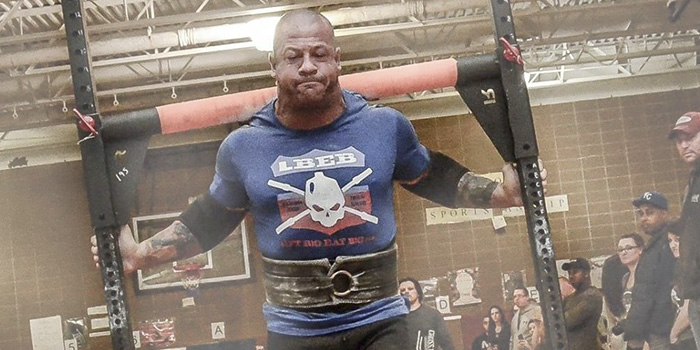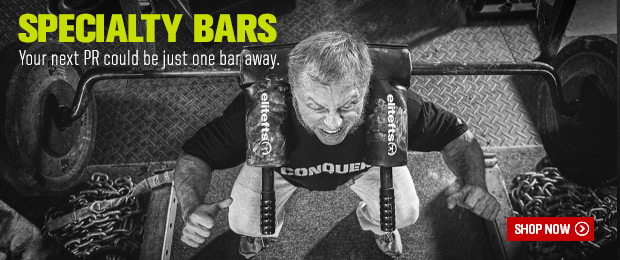
Squatting in strong(wo)man has been somewhat controversial for years. There is one side of the argument that says you must squat and squat often, while another side doesn’t put it as a priority at all. I feel the best approach is somewhat in the middle.
For the point of this article, I’m assuming you do not have a squat event coming up in any competition, as it has become very rare. We see it quite frequently in World’s Strongest Man, but unfortunately hardly at all at the lower levels. I have competed in strong(wo)man in roughly 40 competitions and have still not squatted for an event.
RECENT: Get Bigger, Stronger, and Leaner with 1 Move
The squat for strong(wo)man is an accessory movement and needs to be programmed as such. With that being said, you need to absolutely squat with some variation to be your best at the sport. How the squat is programmed will make the biggest impact on your event training.
A big mistake I see is competitors going too heavy on the squat, as in reps under five. As someone who competes in powerlifting as well, heavy squats and heavy yoke make a recipe for very pissed off knees.
Squatting in the 65 percent to 80 percent is what I find works best. Now you can squat in a hypertrophy block for reps of eight to 12 for three to four sets, or use a higher number of sets with a lower rep scheme, like six sets of three at 80 percent. Now I know many of you like to max out on certain lifts, but remember working up to a 1RM is only a test of strength; you build strength and mass through reps.
If you want to have a big yoke/farmers walk, then you need to have big legs. I have yet to see anyone move quickly with 800 pounds or more on their back with twigs. Use the squat as a mass builder, and you will be faster in moving events and have stronger support. Also having more muscle on the legs will also prevent injury. Weaker quads and/or hamstrings are only going to put more stress on your joints, and as we know, the sport of strong(wo)man has a very high injury rate.
The exercise selection should vary depending on what your events are, and even how you feel as far as injuries go. There are a lot of squat variations we can use, and all have their benefits to the sport. I will say one thing: If you are competing in strong(wo)man, then I really see no need to squat with a regular bar.
For many competitors, squatting with a regular bar places too much stress on the elbows and shoulders. The elbows and shoulders need to be healthy to press heavy weights, so there is no need to place more stress on them. Instead, squat with an SS Yoke Bar or a Rackable Cambered Squat Bar. I really feel specialty bars are a must for squatting as a strong(wo)man competitor, especially for the heavyweights out there. I know for many of us, it’s difficult to get in position on a regular bar, and it has caused me some elbow problems in the past. I was only able to fix that problem by rotating in specialty bars, even while competing in powerlifting.
RELATED: Strongman Gear 101: Everything You Need for Your Strongman Competition
I will agree with the majority of strong(wo)men that the front squat is king for the sport. So many events require you to lift implements to your chest to either carry or press overhead. The clean of a log press and the loading of an atlas stone are both very similar to the front squat. Also for both of these movements, you have to briefly pause in the squat position before exploding up, which is why pause front squats are the best variation you can use. You don’t need to pause long; similar to pause squats, deadlift for two to three seconds. That’s all you need. Personally, I like to use the SS Yoke Bar again but flip it around so the handles are facing you. This angle, I find, makes it much more comfortable to have the bar sit on your shoulders. If you have trouble holding a regular bar in the rack position, give these a try instead.
Also be sure to check out the new Front Squat Harness that is also great for front squats and Zercher Squats, which I will get to later. Our man Clint Darden loves front squatting with this harness.
Another squat that I feel is great for strong(wo)man is the Hatfield squat. I like to think of it as a standing leg press. It’s more of a full body lift, which just about any strong(wo)man event is as well. Knee problems can creep up when walking with a triple-body weight yoke and trying to sprint with a couple hundred pounds in your hands for farmers walks. When regular squatting is causing more pain than developing strength, then give these a try. While holding on to the rack, you can keep yourself perfectly upright while taking the stress off the knees at the bottom.
The box squat is one of my absolute favorite squat variations to use for strong(wo)man. Again, when done correctly it’s very easy on the knees. I have to stress done correctly because I see this being butchered quite a bit, so make sure your form is on point. There are numerous articles here on elitefts that will teach you proper form.
The main benefit of the box squat for strong(wo)man is hip strength. Literally everything in the sport requires strong hips to drive weight up. Deadlift events in strong(wo)man are commonly raised, and the box squat is perfect to improve your lockout from a raised deadlift. Avoid the regular bar here again and use the Spider Bar. This bar doesn’t beat your shoulders and elbows up, and it makes your upper back and core work extra hard to be stable. A strong upper back and a strong core are crucial to the sport of strong(wo)man.
The Zercher Squat is another great squat variation to use to build up your core and legs for strong(wo)man events. If you are training for a Conan’s wheel or front yoke carry, this should definitely be in your program. The Zercher Squat will build your traps, core, legs, and even your biceps. The biceps are a very important muscle to the sport as well as one that is very commonly injured.
Zercher squats can also restrict your breathing from where the bar is placed, and they are just straight-up uncomfortable, which builds mental toughness. For those of you who have done a Conan’s wheel or Husafell for max distance, you can see how building mental toughness is crucial. The way I recommend to do Zerchers is with either a Fat Bar, SS Yoke Bar, as seen below, or with the Front Squat Harness on the lower hooks.
Now that we know the best variations to use, let’s put it all together in a program with events.
We’ll stick to the basic events, which are where I like to put yoke, farmers, and loading medleys on the days that I squat.
- Farmers Walk: 3 x 50 feet. Rating of perceived exertion: 9.
- Yoke or Medley (depending on your events): 2 x 50 feet. Rating of perceived exertion: 8.
- Front Squat: 3 x 8, 65 percent. Your legs will be smoked from the events, so you may have to adjust the percentage here depending on what kind of shape you are in. If the events were a Conan’s wheel or Yoke front carry, then the best option would be a Zercher squat.
- Bulgarian Split Squat: 3 x 10e. ALWAYS include single-leg training in a strong(wo)man program.
- Glute Ham Raises or Hamstring Curls: 3 x 12.
READ MORE: Improve Your 1RM Squat with These Variations
Let’s say you are someone with beat-up knees, and the front squat isn’t working for you. Then it’s best to implement the Hatfield squat or the box squat set to the right height that does not cause pain.
From a programming standpoint, if you feel that squats are zapping your recovery, then you can take them out two or three weeks out from the competition to make sure you are recovered 100 percent.











1 Comment